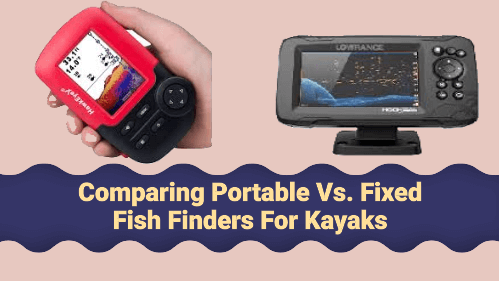Picture this: you’re out on the water, kayak gliding smoothly, but the fish just aren’t biting. You wonder what’s lurking below. That’s where portable fish finders come in.
In this Fish Finders Comparison, I’ll show you how these versatile gadgets can transform your fishing experience. Whether you’re moving between kayaks, ice fishing in the cold, or casting from the shore, these devices are built to tag along and help you find what you’re after
That’s what you get with these adaptable gadgets. And if you’re the kind who jumps from kayaking to ice fishing to shore angling, you’re in for a treat because many portable models can tag along on those adventures too.
Easy Installation
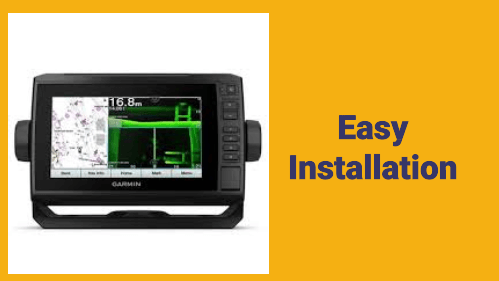
You’re going to find out about installation so straightforward, it almost feels like cheating. Quick setup is the name of the game since these units often come equipped with suction cups or other non-permanent mounting options.
Just pop it on, and you’re good to go. And don’t worry too much about damaging your kayak; there’s no need for drilling, which means the integrity and resale value of your craft stays intact.
Now, if you’re always on the move, you’ll appreciate how travel-friendly these fish finders are. Compact and lightweight, they easily fit into your gear without weighing you down.
Battery Life and Performance Trade-offs
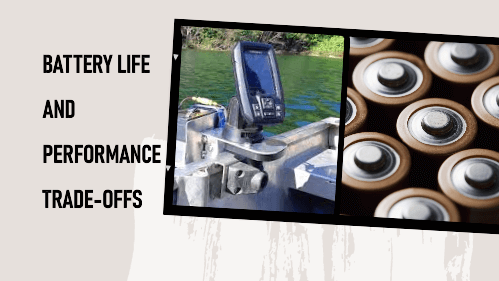
But this mobility comes with a few compromises. Battery life can be a tricky issue; managing spare batteries or finding the time and place to recharge can be a hassle, especially on longer trips. And while portable units are impressive, they typically don’t pack the same punch as their fixed counterparts, which might limit your depth and range capabilities.
Challenges with Stability and Features

Another point to consider is the fight against the elements. The stability of your fish finder is crucial, and let’s face it, suction cups might not always hold their ground in rough waters, which could lead to less accurate readings.
Smaller screens and fewer features compared to fixed units can also be a downside if you’re after high-definition displays or advanced sonar technologies. However, for many, the trade-offs are worth the convenience and flexibility of a portable system.
The Case for Fixed Fish Finders: When Performance Takes the Lead
In my opinion, if performance is your primary concern, fixed fish finders stand out as the go-to choice. Their robust feature set and technical prowess are what set them apart. I’m going to unpack the benefits so you can see if a fixed unit aligns with your angling needs.
Advanced Capabilities
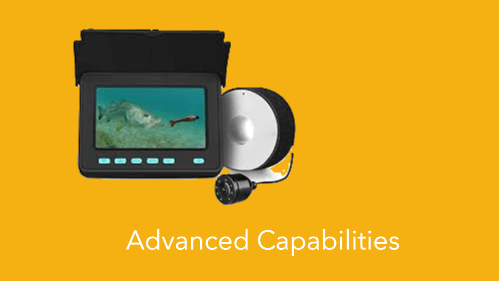
First off, the advanced capabilities of fixed fish finders can be a real game changer. You’re going to find out about sophisticated sonar options, GPS mapping, and crisper display quality. For those who are serious about fishing, these details matter. These features offer more detailed under-water landscapes and fish arches, transforming how you locate your catch.
Power Reliability

A common concern with electronics on a kayak is power reliability. With fixed fish finders, you’re tapping into the kayak’s power system for a consistent and uninterrupted energy source. This means there’s no need to worry too much about battery life or carrying spares, keeping your focus firmly on the fish.
Stability and Durability

Stability and durability play a big role, too. Choose something that resonates with you in terms of setup: Fixed fish finders offer a secure installation that easily weathers rough conditions and water movement. And let’s face it, the rugged construction that comes with many fixed models also means better protection against inclement weather.
Screen Size and Clarity
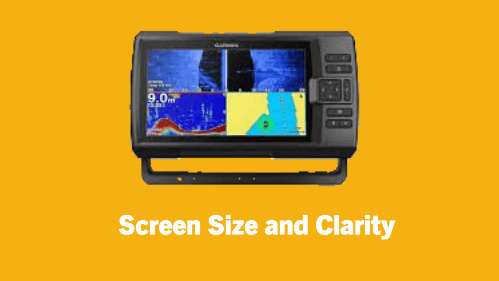
When it comes to screen size and clarity, the difference can sometimes feel like night and day. Larger displays allow for comfortable viewing from any angle and in a range of lighting conditions. You won’t be squinting to see the fish or map contours, which means a better experience overall.
Installation Complexity
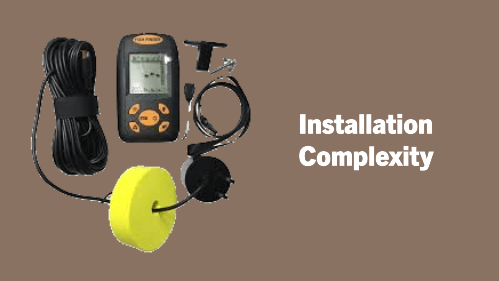
Now, I’m not sidestepping the installation factor. It’s admittedly more complex and can sometimes require professional help.
Yes, that means additional costs both in terms of money and effort. However, if a superior fishing experience is at the top of your list—and you don’t mind the kayak modifications—a fixed fish finder is worth considering.
Portable Versus Fixed: A Side-by-Side Comparison
Let’s put portable and fixed fish finders head to head. If you’re puzzling over which type best suits your needs, consider the key differences that can sway your decision.
You’ll want to weigh the pros and cons of each based not only on what they can do but also how they’ll fit into your fishing lifestyle.
Versatility

Starting with versatility, portable fish finders are the Swiss Army knives of sonar devices. They thrive on flexibility and are ideal if you’re the kind of angler who doesn’t stick to one spot or kayak.
On the flip side, fixed units are the dedicated workhorses, tailored for anglers who have a single kayak and demand the highest level of sonar performance.
Price
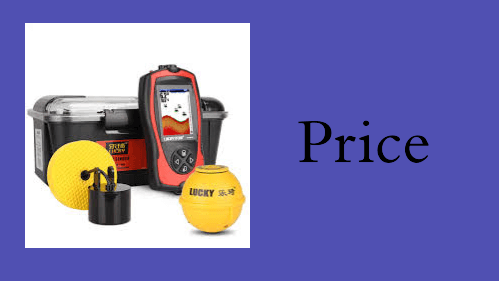
When it comes to price, portables often win in the short run—they’re perfect if you’re watching your wallet and want to avoid extra installation costs. In contrast, fixed fish finders represent a bigger upfront investment, but for good reason. They’re loaded with features that can make a serious difference in how you track the catch of the day.
Ease of Use
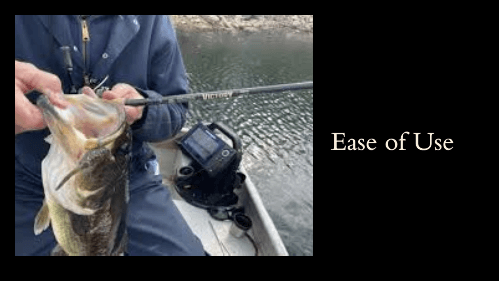
Ease of use is another big talking point. If you prefer the plug-and-play approach, portable units are a no-brainer. They’re user-friendly right out of the box.
But if you’re savvy with tech and don’t mind a more involved setup, the permanence and higher tech of fixed finders might be more your speed. They offer a robust solution that, once installed, provides unmatched reliability.
Screen Size and Features

Now, think about screen size and the feature set you really need. Portable finders generally come with smaller screens and a simpler interface, which can be more than enough for casual fishing trips.
However, fixed fish finders deliver with larger, clearer displays and a treasure trove of advanced capabilities like GPS mapping—features that can elevate your angling game.
Stability and Power

Lastly, let’s talk about stability and power. While portable units give you the freedom to move, they sometimes falter in rough waters where stability is key. Fixed devices, however, are mounted firmly to your kayak, offering dependable performance.
And when it comes to power, fixed finders are connected directly to your kayak‘s energy source, so there’s no mid-trip battery swap to worry about.
Choosing the Right Fish Finder for Your Kayak: A Guided Approach
Now, after weighing the pros and cons of both portable and fixed fish finders, it’s time for you to make an informed decision that best suits your angling needs.
Remember, what works for one may not work for all, so choose something that resonates with you and your particular situation.
Consider Your Kayaking Style and Budget
In my opinion, while factoring in your kayaking style is crucial, never underestimate the impact of your budget. You might find a portable fish finder satisfies your needs without stretching your wallet.
Alternatively, you may decide that the features of a fixed unit are worth the extra investment, especially if it aligns with your long-term fishing goals.
Assess Your Technical Skills
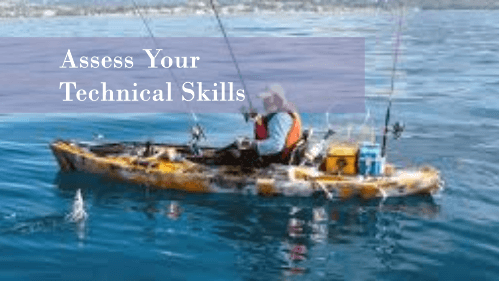
I also urge you to consider your own technical skills and how comfortable you are with the installation process. Don’t worry too much about getting everything right the first time around. You can always adjust your approach down the road.
Ease of Use and Enjoyment
Decide based on what will give you the greatest ease of use, convenience, and, above all, enjoyment on your fishing trips. I really hope that by now, you have a clearer picture of what’s going to fit best on your deck—or in your tackle box.
And remember, your first attempt doesn’t need to be your last. Angling is as much about adapting as it is about the catch.
